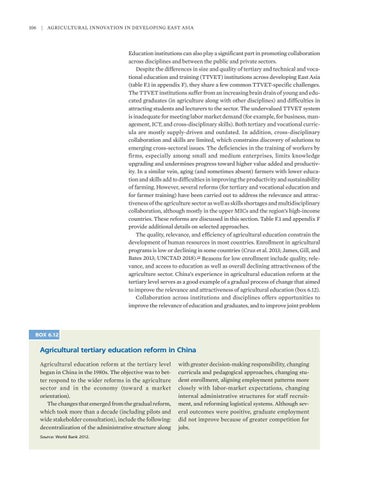106 | Agricultural Innovation in Developing East Asia
Education institutions can also play a significant part in promoting collaboration across disciplines and between the public and private sectors. Despite the differences in size and quality of tertiary and technical and vocational education and training (TTVET) institutions across developing East Asia (table F.1 in appendix F), they share a few common TTVET-specific challenges. The TTVET institutions suffer from an increasing brain drain of young and educated graduates (in agriculture along with other disciplines) and difficulties in attracting students and lecturers to the sector. The undervalued TTVET system is inadequate for meeting labor market demand (for example, for business, management, ICT, and cross-disciplinary skills). Both tertiary and vocational curricula are mostly supply-driven and outdated. In addition, cross-disciplinary collaboration and skills are limited, which constrains discovery of solutions to emerging cross-sectoral issues. The deficiencies in the training of workers by firms, especially among small and medium enterprises, limits knowledge upgrading and undermines progress toward higher value added and productivity. In a similar vein, aging (and sometimes absent) farmers with lower education and skills add to difficulties in improving the productivity and sustainability of farming. However, several reforms (for tertiary and vocational education and for farmer training) have been carried out to address the relevance and attractiveness of the agriculture sector as well as skills shortages and multidisciplinary collaboration, although mostly in the upper MICs and the region’s high-income countries. These reforms are discussed in this section. Table F.1 and appendix F provide additional details on selected approaches. The quality, relevance, and efficiency of agricultural education constrain the development of human resources in most countries. Enrollment in agricultural programs is low or declining in some countries (Cruz et al. 2013; James, Gill, and Bates 2013; UNCTAD 2018).23 Reasons for low enrollment include quality, relevance, and access to education as well as overall declining attractiveness of the agriculture sector. China’s experience in agricultural education reform at the tertiary level serves as a good example of a gradual process of change that aimed to improve the relevance and attractiveness of agricultural education (box 6.12). Collaboration across institutions and disciplines offers opportunities to improve the relevance of education and graduates, and to improve joint problem
BOX 6.12
Agricultural tertiary education reform in China Agricultural education reform at the tertiary level began in China in the 1980s. The objective was to better respond to the wider reforms in the agriculture sector and in the economy (toward a market orientation). The changes that emerged from the gradual reform, which took more than a decade (including pilots and wide stakeholder consultation), include the following: decentralization of the administrative structure along Source: World Bank 2012.
with greater decision-making responsibility, changing curricula and pedagogical approaches, changing student enrollment, aligning employment patterns more closely with labor-market expectations, changing internal administrative structures for staff recruitment, and reforming logistical systems. Although several outcomes were positive, graduate employment did not improve because of greater competition for jobs.

